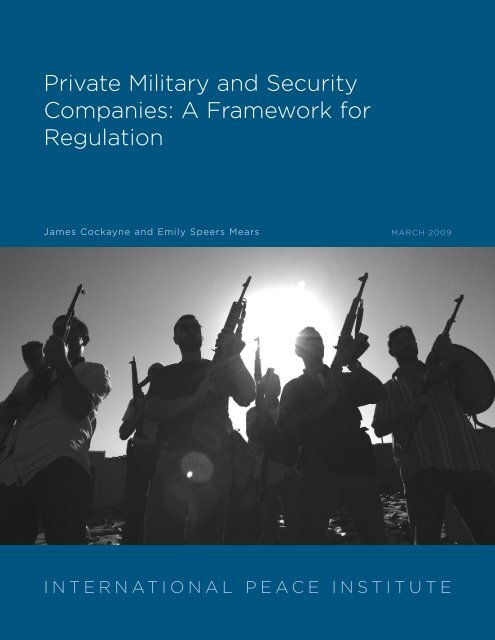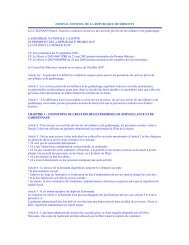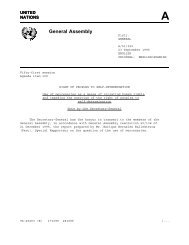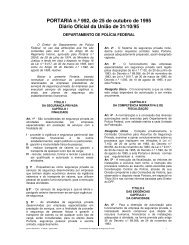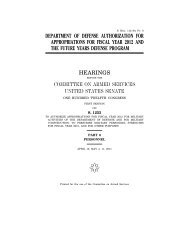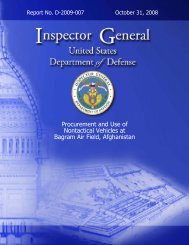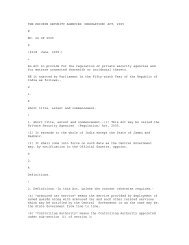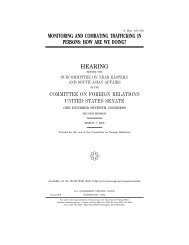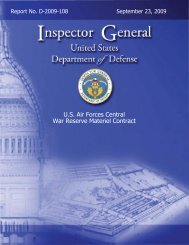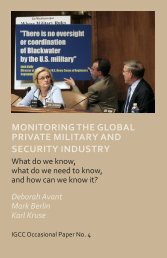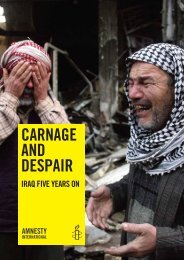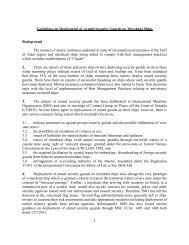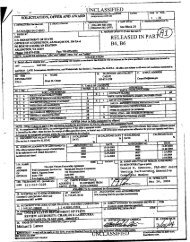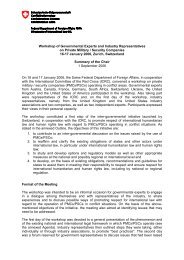A Framework for Regulation - Private Security Monitor
A Framework for Regulation - Private Security Monitor
A Framework for Regulation - Private Security Monitor
- No tags were found...
You also want an ePaper? Increase the reach of your titles
YUMPU automatically turns print PDFs into web optimized ePapers that Google loves.
<strong>Private</strong> Military and <strong>Security</strong>Companies: A <strong>Framework</strong> <strong>for</strong><strong>Regulation</strong>James Cockayne and Emily Speers MearsMARCH 2009INTERNATIONAL PEACE INSTITUTE
Cover Photo: Members of a privatesecurity company pose on therooftop of a house in Baghdad,September 18, 2007. ©Patrick Baz/AFP/Getty ImagesThe views expressed in this paperrepresent those of the authors andnot necessarily those of IPI. IPIwelcomes consideration of a widerange of perspectives in the pursuitof a well-in<strong>for</strong>med debate on criticalpolicies and issues in internationalaffairs.IPI PublicationsAdam Lupel, EditorEllie B. Hearne, Publications Officer© by International Peace Institute,2009All Rights Reservedwww.ipinst.orgABOUT THE AUTHORSJAMES COCKAYNE is Senior Associate at the InternationalPeace Institute, where he co-manages the Coping withCrisis research program. He has spoken and publishedwidely on the reorganization of global violence, focusingon multilateral responses to commercial armed groups,peace operations, and international humanitarian law.EMILY SPEERS MEARS is a writer and researcher onhumanitarianism and security. In 2008 she completed anMPhil in International Relations at the University of Ox<strong>for</strong>d,and acted as assistant coordinator of the EuropeanInteragency <strong>Security</strong> Forum, a network of security focalpoints <strong>for</strong> humanitarian NGOs.ACKNOWLEDGEMENTSThe International Peace Institute (IPI) owes a great debt ofgratitude to its many donors to the program Coping withCrisis, Conflict, and Change. In particular, IPI is grateful tothe governments of Belgium, Canada, Denmark, Finland,Greece, Luxembourg, the Netherlands, Norway, Spain,Sweden, Switzerland, and the United Kingdom. This policyreport is based on the book-length study, Beyond MarketForces, by James Cockayne, Emily Speers Mears, IvetaCherneva, Alison Gurin, Sheila Oviedo, and Dylan Yaeger.A special debt of gratitude is owed to Andrew Claphamand Annyssa Bellal at the Geneva Academy of InternationalHumanitarian Law and Human Rights <strong>for</strong> their cooperationand encouragement, and <strong>for</strong> making available the servicesof Iveta Cherneva. We would also like to thank GrahamBaxter, Lucy Amis, and Birgit Errath at the InternationalBusiness Leaders Forum <strong>for</strong> generously hosting aTroubleshooting Workshop in London on September 2,2008.Thanks are also due to the many interlocutors that assistedwith the preparation of specific sections of the book-lengthstudy or commented on sections of earlier drafts: ChristineBader, Andrew Bearpark, Penny Beels, Christopher Beese,Amada Benevides, Jonathan Bonnitcha, Oliver Broad, DougBrooks, Rachel Davis, Rebecca DeWinter-Schmitt, BirgitErrath, Ann Feltham, Richard Fenning, Jolyon Ford, J.L.Gomez del Prado, Hugo Guerrero, Sabelo Gumedze, CananGunduz, Kevin Lanigan, Mauricio Lazala, Sean McFate, J.J.Messner, Kevin O’Brien, Gerald Pachoud, Erica Razook,Caroline Rees, Timothy Reid, Jean S. Renouf, NilsRosemann, Chris Sanderson, Sabrina Schulz, Salil Tripathi,Lee Van Arsdale, Eric Westropp, Scott Wilson.
CONTENTSAcronyms . . . . . . . . . . . . . . . . . . . . . . . . . . . . . . . . . . . . . . iExecutive Summary . . . . . . . . . . . . . . . . . . . . . . . . . . . . . 1Introduction . . . . . . . . . . . . . . . . . . . . . . . . . . . . . . . . . . . 2The Limits of Existing Regulatory Ef<strong>for</strong>tsand How they Could be Supplemented . . . . . . . . . . . 3STATE EFFORTSINDUSTRY EFFORTSINTERGOVERNMENTAL EFFORTSCIVIL SOCIETY EFFORTSFive Global <strong>Framework</strong> Blueprints. . . . . . . . . . . . . . . . 51. A GLOBAL WATCHDOG2. AN ACCREDITATION REGIME3. AN ARBITRAL TRIBUNAL4. A HARMONIZATION SCHEME5. A GLOBAL SECURITY INDUSTRY CLUBWhat Next? Three Steps TowardRealizing a Global <strong>Framework</strong>. . . . . . . . . . . . . . . . . . . 15
James Cockayne and Emily Speers MearsiAcronymsBAPSCBHRRCFATFGSIICASICRCICTIIHLIPOANGOOECDOPCWPMSCPSCAISIEFUNVPSHRWTOBritish Association of <strong>Private</strong> <strong>Security</strong> CompaniesBusiness and Human Rights Resource CentreFinancial Action Task ForceGlobal <strong>Security</strong> Industry—the industry made up of PMSCsInternational Council of Arbitration <strong>for</strong> SportInternational Committee of the Red CrossInternational Council of Toy IndustriesInternational Humanitarian LawInternational Peace Operations AssociationNongovernmental organizationOrganization <strong>for</strong> Economic Cooperation and DevelopmentOrganization <strong>for</strong> the Prohibition of Chemical Weapons<strong>Private</strong> military and security company<strong>Private</strong> <strong>Security</strong> Company Association of IraqStandards implementation and en<strong>for</strong>cement framework—any framework addressedin this study.United NationsVoluntary Principles on <strong>Security</strong> and Human RightsWorld Trade Organization
James Cockayne and Emily Speers Mears 1Executive SummaryIn late 2008, seventeen states, including the US, UK,China, Iraq, and Afghanistan, endorsed theMontreux Document on Pertinent InternationalLegal Obligations and Good Practices <strong>for</strong> StatesRelated to Operations of <strong>Private</strong> Military and<strong>Security</strong> Companies During Armed Conflict. Thisprovides important guidance to states in regulating<strong>Private</strong> Military and <strong>Security</strong> Companies (PMSCs).But there is a need to do more, to provide increasedguidance to industry and ensure standards areen<strong>for</strong>ced.The arrival of a new administration in the UnitedStates offers a unique opportunity <strong>for</strong> rethinkingthe global regulation and accountability of privatemilitary and security companies. There are positivesigns that the Obama administration will step upef<strong>for</strong>ts to improve regulation, both domesticallyand internationally. And there are signs that otherstates, such as Switzerland, the UK, and Canada, arewilling to do more. Yet domestic regulation is notenough, because the industry is increasingly global.Even many of the PMSCs employed by the USgovernment are incorporated offshore, and recruitthird-country nationals that they then deployoverseas without their ever having entered USjurisdiction.What is needed is a roadmap toward effectiveinternational regulation. There are now adequatestandards in place to develop a global framework toguide implementation and en<strong>for</strong>cement. 1 What islacking is an understanding of the options available<strong>for</strong> implementing and en<strong>for</strong>cing these standards.This policy report examines these options, andidentifies five blueprints <strong>for</strong> the development of aglobal framework.During 2008, the International Peace Institute(IPI) reviewed thirty standards implementation anden<strong>for</strong>cement frameworks in a range of globalindustries, including the financial, extractive, textileand apparel, chemical, toy, toxic-waste disposal,sporting, and veterinary sectors, to identify howsuch a framework might be constructed <strong>for</strong> theglobal security industry (GSI). The result was anearly 200-page study, Beyond Market Forces:Regulating the Global <strong>Security</strong> Industry. A consultationdraft of the study was commented on by adiverse set of industry stakeholders (results availableat www.ipinst.org/gsi). This policy reportsummarizes the resulting key policy options.Beyond Market Forces identifies five differenttypes of frameworks that could be applied to theGSI. These frameworks all go beyond reliance onmarket <strong>for</strong>ces and unilateral national regulation,providing mechanisms that should assist states inregulating the GSI. The aim is not to compete witheffective national regulation—which is essential—but to facilitate and supplement it.The study identifies four design principles thatcould shape effective standards implementationand en<strong>for</strong>cement in this industry. It argues that anyeffective global framework should1) assist states to discharge their legal duty toprotect human rights;2) involve all relevant GSI stakeholders, includingstates;3) use “smart incentives” to encouragestakeholder involvement and influence theirconduct; and4) improve PMSCs’ accountability to clients, thecommunities they operate in, and otherstakeholders.On the basis of these design principles, andBeyond Market Forces’ review of thirty standardsimplementation and en<strong>for</strong>cement frameworks inother global industries, this policy report providesblueprints <strong>for</strong> five different frameworks that mightbe developed immediately <strong>for</strong> the GSI, on the basisof existing standards:1) a global watchdog;2) an accreditation regime;3) an arbitral tribunal;4) a harmonization scheme; and5) a global security industry club.The report describes how each of the blueprintswould add value to existing state, industry, and civil1 The Montreux Document should also be read in conjunction with other relevant standards: the Geneva Conventions (1949) and Additional Protocols (1977), theUniversal Declaration on Human Rights (1948), the UN Code of Conduct <strong>for</strong> Law En<strong>for</strong>cement Officials (1979), the UN Basic Principles on the Use of Force (1990), andthe ILO Conventions and Recommendations. Other existing standards, such as the Voluntary Principles on <strong>Security</strong> and Human Rights and the Sarajevo Code ofConduct and Client Guidelines, may also be applicable to the activities of PMSCs in specific contexts.
2 PRIVATE MILITARY AND SECURITY COMPANIESsociety regulatory ef<strong>for</strong>ts. It outlines thegovernance structure, financing, barriers todevelopment, and added value of each. And itsuggests that it may be necessary to combinedifferent blueprints to construct one overalleffective framework. A final section sets out thesteps that stakeholders need to take in order torealize such a comprehensive global framework <strong>for</strong>the GSI on the basis of these blueprints.IntroductionIn the last decade, commercially organized securitypersonnel have become an increasingly commonsight around the world, from protecting shoppingmalls in the American Midwest to providingconvoy security in the Middle East. They are theincreasingly visible side of an industry that providesa wide range of services related to the provision,training, coordination, and direction of securitypersonnel, and re<strong>for</strong>m of their institutions.In many cases, small local subcontractors andlarge multinational companies are connectedthrough subcontracting arrangements, jointventures, personnel movements, and subsidiarystructures. Together, they <strong>for</strong>m a complex web ofcommercial providers of guarding and protectionservices; operational support in combat, intelligence,interrogation, and prisoner detentionservices; and advice to, training of, and re<strong>for</strong>m oflocal <strong>for</strong>ces and security personnel. They <strong>for</strong>m, inother words, a global security industry.The global security industry (GSI) has undergoneparticularly dramatic growth following the US-ledmilitary campaigns in Iraq and Afghanistan. In theensuing years, it has received particular attentionregarding its perceived lack of respect <strong>for</strong> humanrights and international humanitarian law (IHL), aswell as labor rights and other standards relating tocorporate responsibility. Evidence of industryviolations of these standards remains partial,disputed, and problematic. However, the persistenceand plausibility of such allegations has notbeen effectively matched by improved regulationand accountability, either on the part of states,which bear the primary duty of regulation, or fromother stakeholders in the GSI. Indeed, existingregulation of the industry has received widespreadcriticism <strong>for</strong> a lack of transparency and—in particular—alack of appropriate accountability <strong>for</strong>violations of human rights and IHL by PMSCpersonnel.These criticisms get to the heart of the regulatoryproblem: the lack of industry-wide standards toprotect human rights and ensure respect <strong>for</strong> IHL,and effective arrangements <strong>for</strong> their implementationand en<strong>for</strong>cement. Collaborative regulatoryaction is clearly needed to secure the future of theindustry—or at least to secure the human rights ofthose it affects—so long as the industry continuesto thrive in a free market. And such collaborativeregulatory action is clearly in the interests of notonly those affected by the conduct of the industry,but those with financial, political, or personalstakes in it.This report’s call to improve the implementationand en<strong>for</strong>cement of human rights and IHL, as wellas other standards in the global security industry,should there<strong>for</strong>e be understood not only as one partof a larger ef<strong>for</strong>t to mitigate the risk of furtherhuman rights violations by PMSCs, but also as anattempt to harness the potentially positive contributionto security, development, good governance,and even the enjoyment of human rights, that suchan industry—if effectively regulated—has thecapacity to offer.As demonstrated below, national regulation,company codes, intergovernmental ef<strong>for</strong>ts, andcivil society initiatives have all, so far, fallen short inremedying these failings. And reliance on the“invisible hand” of market <strong>for</strong>ces to achieveeffective regulation does not seem to have protectedall stakeholders’ interests. Among others, the UNSpecial Representative on Business and HumanRights, Professor John Ruggie, has pointed to theneed <strong>for</strong> the general lessons of “business andhuman rights” to be applied in considering thespecific question of how to improve the regulationof PMSCs, including through international andmultistakeholder arrangements. 2 We need to gobeyond unilateral state regulation and beyondmarket <strong>for</strong>ces.This report argues <strong>for</strong> a global framework toidentify, implement, and en<strong>for</strong>ce relevantstandards across the industry, assisting states to2 United Nations Secretary-General, Business and Human Rights: Mapping International Standards of Responsibility and Accountability <strong>for</strong> Corporate Acts, UN Doc.A/HRC/4/035, February 9, 2007, p. 18.
James Cockayne and Emily Speers Mears 3achieve effective regulation. Such a standardsimplementation and en<strong>for</strong>cement framework(SIEF) would have both a preventive and a remedialaspect: it would ensure behavior in compliance withnational and international legal norms, as well asensuring accountability in cases of noncompliance.Such a framework would thus assist both industryin discharging its responsibility to respect humanrights, and states in discharging their legal duty toprotect human rights, as well as help both state andindustry to remedy human rights violations. And itcould harness—and supplement—existing ef<strong>for</strong>tsin order to do so.The Limits of ExistingRegulatory Ef<strong>for</strong>ts andHow they Could beSupplementedSTATE EFFORTSThere are two main problems with existing stateef<strong>for</strong>ts to regulate the GSI. The first relates to theinadequate substantive and geographical reach ofexisting regulation. The second relates to the lack ofeffective en<strong>for</strong>cement of regulatory instrumentswhich are in place, particularly in the area ofhuman rights law and IHL. Given states’fundamental legal duty to protect, states shouldtake steps to overcome these shortcomings; butgiven the global nature of the industry, that issomething states may find they cannot do actingalone—or even together, absent support fromindustry and civil society.At present, the most developed ef<strong>for</strong>ts toimplement and en<strong>for</strong>ce standards within the GSIare occurring at the level of home and contractingstate regulation. However, home states often lackthe regulatory reach to effectively implement anden<strong>for</strong>ce human rights and other standards in theirPMSCs’ offshore operations. And many of themajor home states <strong>for</strong> the GSI—such as the US andUK—are also themselves major contracting states.Contracting states are open to charges of conflict ofinterest in their dealings with the GSI, since theyare not only the watchdogs <strong>for</strong>, but also the clientsof, the industry. These states may have justifiedinterests in limiting industry transparency (such asnational security concerns). But in protecting theirown interests they may unhelpfully—ifunwittingly—limit transparency <strong>for</strong> other industryclients (such as extractive companies and humanitarianorganizations). This leads not only to a lackof effective en<strong>for</strong>cement of existing legal obligations,but also to a weakening of the effectiveness ofmarket <strong>for</strong>ces as a regulatory instrument in the GSI.Most existing home and contracting state-basedregulation displays a bias toward “single-state”contracting arrangements, with little attention paidto the increasingly offshore nature of PMSCrecruiting, organization, and contract per<strong>for</strong>mance.Even where national regulatory frameworks arecomparatively developed—as in the US and SouthAfrica—states confront challenges in monitoring,oversight, and accountability <strong>for</strong> the industry’soffshore activities. Perhaps due to concerns abouthow to ensure any such regulation is actuallyeffective, the UK, another significant exporting hubwithin the GSI, has a notably light regulatoryframework.States where PMSCs operate (territorial states),such as Colombia, Afghanistan, and Iraq, have alsobegun to exercise their regulatory authority.However, given that many territorial states arewracked by insecurity or have weak governancearrangements, they lack en<strong>for</strong>cement power.What all this makes clear is that PMSCs operatingtransnationally can easily escape domestic regulation.Numerous obstacles to effective regulationthrough and by states remain around issues such asextraterritorial jurisdiction, evidence collection,and adaptation of public norms to private businessrelationships. And the emergence of uncoordinatedregulatory frameworks at the national level may infact play into the hands of those PMSCs that seek toavoid effective oversight. In some parts of theworld, there is significant evidence of PMSCs beingclosely linked to organized crime 3 and activitiesthat fuel violent conflict, such as trafficking inresources and arms. Given the mobility ofpersonnel within the industry, it is difficult—absenteffective international standards and a globalframework <strong>for</strong> their implementation and en<strong>for</strong>cement—toinsulate some parts of the industry fromthe pernicious effects of such conduct in other partsof the industry.3 This appears to be the case particularly in southeastern Europe and Latin America.
4 PRIVATE MILITARY AND SECURITY COMPANIESINDUSTRY EFFORTSSome PMSCs have long recognized the importanceof guidance on what standards they are expected toabide by and how. They have, consequently,developed an array of internal managementsystems, ethics programs, and controls on the use of<strong>for</strong>ce—both individually, and in cooperation, <strong>for</strong>example, through the British Association of <strong>Private</strong><strong>Security</strong> Companies (BAPSC), International PeaceOperations Association (IPOA), and <strong>Private</strong><strong>Security</strong> Company Association of Iraq (PSCAI). 4Yet these ef<strong>for</strong>ts have gained only limited tractionand done little to ensure effective remedying ofhuman rights violations by industry actors. Theyare heavily criticized by civil society groups <strong>for</strong>failing to provide effective and transparent en<strong>for</strong>cementarrangements. Indeed, the gravity of someallegations about PMSC conduct may make stateinvolvement necessary, if not inevitable—throughrecourse to criminal courts guaranteeing a right tofair trial and due process.In Beyond Market Forces, IPI presents the resultsof a nonscientific examination of more than <strong>for</strong>tyPMSCs, 5 which found that many PMSCs profess tosupport external ethical standards in their publicitymaterials and on their websites. Some also have inplace implementation frameworks <strong>for</strong> otherinternal standards, which are supervised and/ormanaged at the senior management level. Thesemay even include strict hiring and vetting policies,and guidelines on contracts requiring the provisionof armed security services, as well as on howpersonnel may use, and must report the use of,<strong>for</strong>ce.However, the actual level of commitment to anyexternal standard (such as human rights or IHLstandards) is almost always highly ambiguous.PMSCs’ internal standards and en<strong>for</strong>cementarrangements also betray a number of weaknesses.For example, they rarely cover subcontractors. Andeven more importantly, no PMSC examined has aneffective and transparent grievance mechanism thatcould be accessed by third parties which wouldmeet the benchmarks identified by the UN SpecialRepresentative on Business and Human Rights. 6And none has provided transparent arrangements<strong>for</strong> referring allegations of serious human rights orIHL violations by their personnel to relevant stateauthorities.Similar concerns arise in relation to PMSCindustry associations. Of the two largest, at present,the BAPSC provides only broad standards in the<strong>for</strong>m of a charter, though it is currently workingwith its membership to develop more-detailedoperational guidance, in the <strong>for</strong>m of a privateBAPSC standard. And BAPSC currently offers no<strong>for</strong>mal grievance mechanism <strong>for</strong> dealing withcomplaints about its members’ conduct. IPOA doeshave a <strong>for</strong>mal en<strong>for</strong>cement mechanism, but it lackstransparency and appears highly partial, given thatit leaves the en<strong>for</strong>cement of the IPOA Code ofConduct to the unfettered discretion of itsmembership. Nor does it give any <strong>for</strong>mal role tostates or civil society in en<strong>for</strong>cing standards.The global security industry cannot effectivelyimplement and en<strong>for</strong>ce human rights and IHLstandards on its own: industry-only ef<strong>for</strong>ts will lackcredibility in the eyes of the broader public,especially if they do not lead to credible andimpartial en<strong>for</strong>cement action against PMSCpersonnel alleged to be involved in seriousviolations of human rights and IHL. But theinternal standards arrangements developed bysome PMSCs and industry associations couldprovide a starting point <strong>for</strong> supplementing stateregulation and preventing violations of humanrights and IHL being committed in the first place.They may, there<strong>for</strong>e, need to be connected to orfolded into a global framework if it is to add value<strong>for</strong> industry stakeholders.INTERGOVERNMENTAL EFFORTSIntergovernmental ef<strong>for</strong>ts to regulate mercenaries,<strong>for</strong> example through the United Nations, have beenrife with political tensions resulting from the role ofmercenarism in colonial history. This legacy oftension has prevented <strong>for</strong>mal intergovernmentalmechanisms from dealing effectively with thecomplex issue of regulation of the GSI.The ef<strong>for</strong>ts of the UN Human Rights Council’s4 A “Pan African <strong>Security</strong> Association” was also <strong>for</strong>med in 2008. However it remains in its early stages and has not been specifically addressed in this report or thelarger study.5 See the book-length study, James Cockayne, Emily Speers Mears, Iveta Cherneva, Alison Gurin, Shiela Oviedo, and Dylan Yaeger, Beyond Market Forces: Regulatingthe Global <strong>Security</strong> Industry (New York: IPI, <strong>for</strong>thcoming 2009) <strong>for</strong> further details.6 See John Ruggie, Protect, Respect, and Remedy: a <strong>Framework</strong> <strong>for</strong> Business and Human Rights, UN Doc. A/HRC/8/5, April 7, 2008, p. 24.
James Cockayne and Emily Speers Mears 5Working Group on mercenaries remain hamstrungby the baseline unwillingness of PMSCs and homestates to see PMSCs likened to mercenaries, andtreated as an inherent threat to human rights. TheWorking Group has made progress in some keyareas—especially in relation to recruiting and theimpact of personnel returning from working withPMSCs in conflict zones to their home communities—andit could serve an important role indeveloping the kind of global frameworks discussedhere. But, acting alone, the Working Groupcurrently lacks the resources, as well as the access toPMSCs, territorial states, and exporting states—andtheir en<strong>for</strong>cement power—that it would need todevelop such a framework <strong>for</strong> consensual regulationof the industry at the multilateral level.The Swiss Initiative provides the most significantcontemporary international ef<strong>for</strong>t to improvestandards implementation and en<strong>for</strong>cement withinthe GSI. In September 2008, its “MontreuxDocument” was agreed upon by seventeen states—notably including Afghanistan, China, France,Germany, Iraq, Sierra Leone, South Africa, the UK,and the US. It contains a reaffirmation of existinginternational law obligations and over seventy goodpractices <strong>for</strong> states in contracting and regulatingPMSCs. The Montreux Document is explicitlynonbinding and contains no new legal obligations.And it is also limited to states’ dealings with PMSCsin armed conflict. However, it is the most coherent,precise, and widely supported statement of “goodpractice” relating to the global security industry. Assuch, it could <strong>for</strong>m the basis <strong>for</strong> standardsimplementation and en<strong>for</strong>cement in any of the fiveglobal framework blueprints put <strong>for</strong>ward in thisreport.CIVIL SOCIETY EFFORTSCivil society actors have been involved in ef<strong>for</strong>ts toimprove standards implementation within theindustry in a number of ways, predominantlythrough monitoring PMSC behavior. NGOs haveparticipated in single-country ef<strong>for</strong>ts to strengthenthe operational link between security and humanrights, including through the Sarajevo Process andthe Voluntary Principles on <strong>Security</strong> and HumanRights. 7 Some have also assisted in industry ef<strong>for</strong>tsto raise standards or, in the case of the Business &Human Rights Resource Centre (BHRRC),provided a public plat<strong>for</strong>m <strong>for</strong> engaging companiesdirectly when specific concerns arise relating toPMSC conduct.But the sanctioning levers to which civil societysometimes has access—public sentiment andpurchasing power—will require significantmobilization be<strong>for</strong>e they have any real impact onthis industry. Most major industry clients (such asgovernments and extractive industries) are noteasily moved by public pressure, and in<strong>for</strong>mationabout standards violations (which often occuroffshore) is generally ambiguous and difficult toaccess. Civil society activism there<strong>for</strong>e has animportant role to play in raising public awareness ofviolations of human rights and IHL, and the failureto adequately remedy them.Research and policy institutions in the US andEurope have also conducted important research onthe issue of PMSC regulation. But in order <strong>for</strong> theirfull import to be effectively realized, these ef<strong>for</strong>tsneed to feed into a regulatory process. And atpresent, there is no broad process working withstakeholders to think through the practical issuesaround different regulatory options and build acoherent global framework of improved standardsimplementation and en<strong>for</strong>cement. This report’sblueprints advance a number of different ideas <strong>for</strong>how civil society might be involved in the developmentand operation of such a global framework.Five Global <strong>Framework</strong>BlueprintsAny effective Standards Implementation andEn<strong>for</strong>cement <strong>Framework</strong> will need to be based onthe state’s fundamental legal duty to protect humanrights, the corporate responsibility to respect theserights, and the shared obligation to provide accessto a remedy in the case of violations. 8 While nosingle stakeholder group is in a position to providecredible, effective standards implementation anden<strong>for</strong>cement <strong>for</strong> the industry on its own, eachstakeholder group—states, industry, the industry’sclients, and civil society groups—brings somethingto the table. Together or separately, they may needto develop different components of a larger global7 For further details see Cockayne, Mears, et al., the book-length Beyond Market Forces.8 See Ruggie, Protect, Respect, and Remedy.
6 PRIVATE MILITARY AND SECURITY COMPANIESframework that, over time, fosters convergencetoward effective implementation and en<strong>for</strong>cementof shared standards. This report fleshes out fiveblueprints <strong>for</strong> what such a global framework—orcomponents of such a framework—might look like.The five blueprints are based on four designprinciples, which the study Beyond Market Forcesidentifies as the basis <strong>for</strong> effective standardsimplementation and en<strong>for</strong>cement in the industry:1. Any global framework should assist states todischarge their legal duty to protect humanrights.2. It should also involve all relevant GSI stakeholders,including states.3. It will need to use “smart incentives” toencourage stakeholder involvement and toinfluence their conduct.4. And it will need to improve PMSCs’ accountabilityto clients, the communities they operatein, and other stakeholders. It could do sothrough reporting, consultation, improvingclients’, regulators’, and other stakeholders’access to in<strong>for</strong>mation about PMSC per<strong>for</strong>mancein the field, and possibly also through disputeresolutionarrangements.Some of the following blueprints correspondmore fully to these principles than others.Accordingly, it may be necessary to combinedifferent blueprints to construct one overalleffective framework that discharges all of therequirements of these principles.However, the nature of some PMSC misconduct—specificallyrelating to serious human rightsviolations—also makes clear that any suchframework should be able to “plug into” stateen<strong>for</strong>cement mechanisms. Many PMSC humanrightsviolations may need to be adjudicated instate courts through fair trial subject to dueprocess. Any global framework ought to assisteffective judicial determination of human rightsviolations, even if that leaves room <strong>for</strong> morein<strong>for</strong>mal dispute resolution and remedial arrangementsin relation to labor and contract disputes.Existing arrangements such as the OECD’s NationalContact Points <strong>for</strong> implementation of theGuidelines <strong>for</strong> Multinational Enterprises, may servesuch a purpose, but may not prove adequate to dealwith allegations of serious violations of humanrights (such as violations of the right to life) thatrecur in relation to the GSI.Finally, this report notes that while adequatestandards now exist <strong>for</strong> effective transnationalstandards implementation and en<strong>for</strong>cement,further elaboration and operationalization of thesestandards may still be useful. In particular, a globalcode of conduct would amplify the standards in theMontreux Document (which addresses only statesand situations of armed conflict). It could helpcreate greater market transparency and per<strong>for</strong>manceaccountability, and is there<strong>for</strong>e likely to bewelcomed by many parts of the industry, theirclients, civil society, and states. 91. A GLOBAL WATCHDOGA global GSI watchdog would monitor PMSCcompliance with globally applicable industrystandards. 10 Where it found reasonable evidencethat these standards had been violated, it wouldrefer matters to the relevant state authority and/orpublicize the matter. It could take the <strong>for</strong>m of eithera states-backed global GSI ombudsman or—shortof that—be established by the collective action ofnongovernmental organizations (NGOs) andindustry, without state participation. Precedents <strong>for</strong>such a mechanism include the UN framework onChildren and Armed Conflict, the landmine NGOGeneva Call, and the International Committee ofthe Red Cross (ICRC). 11How Would it Work?Whether a states-backed global ombudsman or acreation of NGOs and industry, a global GSIwatchdog would do the following:a) Act as a “guardian” of global GSI standards, 12 by• monitoring compliance by PMSCs (and/ortheir clients, and/or state regulators) withthese standards;• providing desk and field monitoring of areas9 For a draft code of conduct limited to human rights and IHL, and a consideration of how such a code of conduct might be developed, see Nils Rosemann, “Code ofConduct: Tool <strong>for</strong> Self-<strong>Regulation</strong> <strong>for</strong> <strong>Private</strong> Military and <strong>Security</strong> Companies,” Occasional Paper No. 15 (Geneva: Geneva Centre <strong>for</strong> the Democratic Control ofArmed Forces, 2008).10 See documents referred to in note 1, above.11 For analysis of these and other frameworks referred to throughout the report, please refer to Part IV of Cockayne, Mears, et al., Beyond Market Forces.12 In the style of the UN <strong>Framework</strong> on Children and Armed Conflict, Geneva Call, and the ICRC.
James Cockayne and Emily Speers Mears 7of particular concern in which PMSCsoperate, with specific investigations intoviolations conducted by panels of expertsassembled from standing lists drawn fromgovernment officials, industry, clients, andcivil society;• providing a complaints hotline 13 <strong>for</strong> whistleblowers,whose allegations could then triggeran investigation by the watchdog; and by• publishing an annual review of industry-widetrends in compliance with the standards, and adigest of good practices in implementing anden<strong>for</strong>cing them. 14b) Encourage implementation of the global GSIstandards, through• publicizing findings about compliance withGSI standards in specific cases, <strong>for</strong> examplethrough a website; and• passing on any serious concerns or grievancesregarding illegal activity, and relevantin<strong>for</strong>mation, to the appropriate state en<strong>for</strong>cementmechanisms.Any watchdog would have minimal standardsen<strong>for</strong>cement capacity. Were states to explicitlydelegate monitoring power to it, in a similar way tothe ICRC’s monitoring of state and armed groups’compliance with IHL, it might be useful also toendow it with the capacity to engage in confidentialdispute resolution.Governance StructureThe watchdog would consist of a secretariat and aboard. The secretariat would be responsible <strong>for</strong> theday-to-day monitoring and review functions of thewatchdog. In specific cases it would assemble apanel of experts to undertake field inspections.These experts could be drawn from standing listsnominated by different stakeholder groups (states,industry, affected communities, clients, andinvestors) according to a pre-agreed <strong>for</strong>mula. Thesecretariat would require a small permanent staff ofsix to eight, managed by a secretary-general.The secretary-general would be responsible <strong>for</strong>overseeing the direction and daily operation of thesecretariat and guiding its relations with industrystakeholders, including the board. He or she wouldbe a senior, respected figure with an extensivebackground in corporate social responsibility,international security, or human rights advocacy,and would promote the watchdog internationallyand raise both diplomatic and financial support <strong>for</strong>its activities. He or she would be assisted by threestaff. The director <strong>for</strong> monitoring would haveprimary responsibility <strong>for</strong> coordinating andrunning the watchdog’s monitoring activities,including the complaints hotline and organizationof panels of experts. The director <strong>for</strong> good practicewould be responsible <strong>for</strong> developing and editing theannual review of industry compliance and goodpractice, and <strong>for</strong> developing related outreach activities.These officers would be backstopped by anadministrative officer, one or two researchassistants, and two or three clerical and administrativestaff.The board would oversee the watchdog’s strategicdirection, and comprise a maximum of fifteenmembers, all serving elected two-year terms. In astates-backed watchdog, states would hold sevenseats on the board, and chair the meetings on arotating basis. These seven seats would be distributedamong contracting, territorial, and homestates. A further three seats would be held by localand international human rights NGOs and laborunions, three by representatives of the industryitself (drawn from specific PMSCs or from tradeassociations), and two by representatives of clientand investor groups (such as extractive-industryclients, humanitarian organizations, and theinsurance industry). These seats would be filled byelections within each group (with voting rightsperhaps being tied to payment of scaled subscriptionfees). If states did not participate in thewatchdog, the board would operate without them.In either case, the secretary-general would alsoserve as ex officio deputy chair of the board.FinanceThe GSI watchdog would be funded by states,private foundations, retail donations, subscriptions13 Like those established by the International Council of Toy Industries (ICTI) CARE Process, and Clear Voice.14 In promoting good practices it would resemble another “watchdog,” the NGO Transparency International. TI works with governments, businesses, civil societygroups, and other stakeholders to promote transparency in elections, public administration, procurement, and business. However, unlike the GSI watchdogproposed here, Transparency International does not investigate allegations of corruption or expose individual cases. For further in<strong>for</strong>mation, see the organization’swebsite, available at www.transparency.org.
8 PRIVATE MILITARY AND SECURITY COMPANIESfrom electors of members of the board, andpossibly sales of its annual review. This reportestimates an annual operating budget of approximately$1.2 million (c. $600,000 personnel costs;$300,000 operating costs; and $300,000 overheadcosts). Specific investigations would need separatefinancing, which might call <strong>for</strong> the creation of aseparate strategic fund.What are the Barriers?The effectiveness of a watchdog will depend on (1)its access to in<strong>for</strong>mation; and (2) remedial actionbased on the in<strong>for</strong>mation it brings to light.Access to in<strong>for</strong>mation will be facilitated byconnections to civil society networks, industryparticipation, and especially by state support. Statesupport might be facilitated by linking thewatchdog closely to standards they already support.A GSI watchdog could, <strong>for</strong> example, be establishedby states that endorse the Montreux Document, asan aid to assist them in implementing thatdocument. Access to in<strong>for</strong>mation will also dependon stakeholders working with the secretariat toestablish careful protocols to protect nationalsecurity, contractual confidentiality, individualprivacy, and whistleblowers.Effective remedial action will depend on clients,investors, and regulators having access to thewatchdog’s findings about compliance withstandards, and taking appropriate action. Thewatchdog could also be mandated to monitor suchfollow-up.What are the Benefits?The GSI suffers from a chronic lack of markettransparency, and states find standards en<strong>for</strong>cementdifficult because of limited access to reliablein<strong>for</strong>mation about industry per<strong>for</strong>mance. A GSIwatchdog would help fill these gaps, withoutjeopardizing state en<strong>for</strong>cement authority andexisting market arrangements. By clarifying thereality of PMSC per<strong>for</strong>mance, it would makeindustry underper<strong>for</strong>mers accountable to clients,investors, and regulators, while rewarding goodper<strong>for</strong>mers.Given that standards already exist, there are noreal barriers—beyond will and finance—to therelevant GSI stakeholders setting up a watchdog onthe earliest possible date.2. AN ACCREDITATION REGIMEAn accreditation regime that deliberately harnessesmarket-based incentives could be set up immediatelyon the basis of the Montreux Document andthe other existing standards listed above. 15 It couldbe set up by the GSI and its clients either on theirown, or with states’ backing. A credible accreditationregime would create demand <strong>for</strong> standardscompliantPMSCs, and drive up standards acrossthe GSI. And accreditation would operate as amarket signaling device, to turn demand into anincentive <strong>for</strong> compliance and accreditation.Precedents <strong>for</strong> such a regime exist in the globalapparel and manufacturing regimes, in thediamond and chemical industries, and in rudimentary<strong>for</strong>m in the British Association of <strong>Private</strong><strong>Security</strong> Companies and the International PeaceOperations Association. No such regime exists atthe global level <strong>for</strong> the GSI, or with the involvementof clients, investors, and regulators.How Would it Work?An accreditation regime would have three linkedfunctions:a) Certification• To participate, PMSCs and their clients wouldsubmit a completed checklist of compliancewith the framework’s standards, particularlyrelating to vetting of PMSCs and personnel,field management, and reporting of humanrights and labor rights violations. Thischecklist and a preliminary desk and worksitecheck would serve as the basis <strong>for</strong> determiningcompliance with the framework standards.• Companies and clients that fulfill these certificationrequirements would be provided with acertificate, which they would be permitted touse in publicity and marketing. 16• PMSCs would be required to integrate twothirdsof their subcontractors into theframework within three years, to ensurecontinued certification. These subcontractorswould themselves have to undergo certification.1715 See note 1, above.16 As is the case with the Global Compact logo and ICTI.17 As is required by the Business Social Compliance Initiative and ICTI.
10 PRIVATE MILITARY AND SECURITY COMPANIESclients and states would balance out industrymembership fees, enabling the framework tomaintain its independence. This report estimatesthat the secretariat would cost c. $1.5 million perannum (c. $900,000 personnel costs, $300,000operating costs, and $300,000 overhead), notincluding the costs of auditing teams. These wouldbe separately budgeted and should be covered byservice fees.What are the Barriers?The Montreux Document provides importantguidance on how states should expect PMSCs to vettheir personnel, manage them, and deal with allegationsof misconduct. 19 These might provide thebasis <strong>for</strong> an accreditation regime. However, someindustry actors may seek greater specificity in thesestandards be<strong>for</strong>e they are willing to participate inan accreditation regime that creates markettransparency and market signaling mechanisms.Accordingly, it may be useful—though it may notbe necessary—to supplement existing standardswith a code of conduct, as the basis of an accreditationregime.Effective auditing will depend on substantial buyinfrom both industry and from clients, since it mayraise significant issues of national security, clientconfidentiality, and privacy. Yet precedents likethose in the diamond and chemical industriesdemonstrate that with sufficient industry buy-in,certification, auditing, and inspection protocols canbe developed that satisfy such concerns.An accreditation regime would need to functionquickly as well as effectively. It could use a tieredcertification scheme, with PMSCs’ compliance withthe most important standards of human rights andIHL assessed first, providing a preliminary certificationallowing PMSCs to bid <strong>for</strong> contracts whilestill applying <strong>for</strong> complete certification.What are the Benefits?Even a voluntary GSI accreditation regime, if robustand credible, would begin to institutionalize theconnection between standards implementation,market access, and per<strong>for</strong>mance incentives. Itsratings could be picked up and used as the basis ofcontracting and regulating decisions by GSI clients,regulators, financiers, and civil society. And it couldbe set up now on the basis of existing standards.3. AN ARBITRAL TRIBUNALA GSI arbitral tribunal would provide an industrytailored<strong>for</strong>um <strong>for</strong> dealing with the labor, contractual,and other disputes—not including serioushuman rights violations—that occur in thisindustry across multiple jurisdictions every day. Itwould help create a level global playing-field <strong>for</strong> theindustry, reducing administrative costs and regulatoryarbitrage, encouraging cross-border professionalization,and facilitating en<strong>for</strong>cement cooperationby different states. It could also generate anacquis of practice encouraging rising managerialstandards within PMSCs around the world. Themajor precedent <strong>for</strong> such a <strong>for</strong>um is the Court ofArbitration <strong>for</strong> Sport, but it could also draw on theInterpretation Procedure of the InternationalLabour Organization’s Tripartite Declaration. 20Such an arbitral tribunal could be set up immediately,on the basis of existing law and standards.Once the infrastructure and personnel were inplace, the arbitral tribunal would be “activated” bystakeholders granting it jurisdiction over casesthrough references in their contracts, regulations,and investment agreements.How Would it Work?A GSI arbitral tribunal would serve as a <strong>for</strong>um inwhich contractual parties could en<strong>for</strong>ce the termsof their contract, or from which state regulatorscould seek advisory opinions or decisions inspecific cases.• PMSCs and their clients, and PMSCs and theirpersonnel, would specifically consent to submitto the arbitral tribunal’s jurisdiction in theircontracts.• States could mandate the jurisdiction of thearbitral tribunal over certain types of labor orcontractual disputes relating to the industry,regardless of such inclusion by private parties.• These contractual and regulatory referenceswould also give binding <strong>for</strong>ce to the standards—19 Montreux Document on Pertinent International Legal Obligations and Good Practices <strong>for</strong> States Related to the Operations of <strong>Private</strong> Military and <strong>Security</strong> CompaniesDuring Armed Conflict, Part II: Procedure <strong>for</strong> the Selection and Contracting of PMSCs, available at www.eda.admin.ch/psc.20 The Declaration is a set of voluntary principles to guide multinational enterprises, governments, and employers’ and workers’ organizations in adopting socialpolicies and developing good practices. The Interpretation Procedure can be activated by any of these stakeholders in the instance of a dispute regarding theapplication of the Declaration. For more detail, see Part IV of Cockayne, Mears, et al., Beyond Market Forces.
James Cockayne and Emily Speers Mears 11such as the relevant provisions of the MontreuxDocument, the ILO Conventions and relevantRecommendations, and relevant internationallaw—compliance with which the arbitral tribunalwould assess.• Rather than conducting its own investigations,signatories and complainants would be requiredto provide in<strong>for</strong>mation to the arbitral tribunalupon request. This in<strong>for</strong>mation would remainconfidential, unless both parties agreed to itsrelease. The outcome of the tribunal processwould be made public, though written decisionsmight be made available only to the parties.• The tribunal would provide needs-basedassistance <strong>for</strong> those bringing claims, which wouldbe particularly important <strong>for</strong> PMSC employeesand smaller PMSCs.• The decisions of a GSI arbitral tribunal would been<strong>for</strong>ced through states’ domestic jurisdiction, aswith other international arbitration arrangements.• An annual digest of the decisions of the tribunalcould be prepared by the secretariat, as the sourceof an acquis to provide guidance to industrystakeholders.Governance StructureArbitrators would be chosen <strong>for</strong> either their arbitralexperience, or their GSI-related legal experience,and appointed <strong>for</strong> a renewable term of four years.They would be entered into a database by a smallsecretariat, which would receive and processcomplaints. Both parties to the dispute would selectone arbitrator from the database, and agree collectivelyon a third independent arbitrator, or have thethird panel member appointed by the framework’ssecretary-general.The secretariat would be staffed by a secretarygeneraloverseeing the secretariat’s daily operations,engaging in strategic outreach with stakeholders,and representing the regime to the broader internationalcommunity; one full-time administrator toprovide administrative support to the arbitralprocess, maintain its database of arbitrators, andreceive and process complaints and requests <strong>for</strong>needs-based assistance; one outreach officercharged with developing the tribunal’s website andoutreach materials and dealing with the media, aswell as working with the administrator to overseeassistance to parties; one counselor, with dualresponsibility <strong>for</strong> providing legal advice to thesecretary-general and administrator, particularly toensure respect <strong>for</strong> the arbitral regime, and <strong>for</strong>preparing an annual digest of arbitral decisions andnotes on the developing acquis. These four substantivepositions would be supported by a director offinance and administration and two clerical staff,<strong>for</strong> a total of seven staff.FinanceMost of the expenses related to a GSI arbitraltribunal would be borne by the parties. However,states and industry actors might be required toprovide voluntary contributions to a fund to coverthe costs of PMSC personnel complainants, and/orsmall PMSCs. These contributions would also needto cover the operating costs of a small secretariat, topublicize the arbitral tribunal and encourageprivate parties to incorporate references to it andthe standards it en<strong>for</strong>ces in their private legalarrangements; maintain the lists of potentialarbitrators; serve as administrative support to thearbitral process; manage the provision of assistanceto claimants; and prepare an annual digest ofarbitral decisions and acquis. This report estimatesthe annual costs of such an enterprise to be approximately$900,000 per annum ($600,000 personnelcosts, $150,000 operating costs, and $150,000overhead).What are the Barriers?A GSI arbitral tribunal would not deal directly withthe key regulatory problem <strong>for</strong> the GSI: preventingand remedying PMSC violations of human rightsand IHL. It may not, there<strong>for</strong>e, receive muchsupport from civil society. But its encouragement ofcross-border harmonization in labor managementpractices and facilitation of sanctioning of contractualunderper<strong>for</strong>mance might indirectly assist withimproving respect <strong>for</strong> other standards in the GSI.What are the Benefits?The tribunal would offer industry-sensitive, timeefficient, and cross-border harmonized resolutionof complaints regarding adherence to labor andcontractual standards. It would significantly reducetransaction and dispute-resolution costs <strong>for</strong> allindustry stakeholders, assist states by supplementingtheir domestic en<strong>for</strong>cement options, andencourage improved respect <strong>for</strong> other standards in
12 PRIVATE MILITARY AND SECURITY COMPANIESthe industry. It seems likely that any such arbitraltribunal might deal with disputes about occupationalhealth and safety, and workplace personnelmanagement, which could have a significant effecton the upstream and downstream impacts ofPMSCs.4. A HARMONIZATION SCHEMEA GSI harmonization scheme would encourageharmonization of national regulatory arrangementsand/or PMSC management arrangements aroundthe standards codified in the Montreux Document,and other agreed international standards. Such ascheme could operate on a decentralized butcoordinated basis, with different states (or PMSCs)taking responsibility <strong>for</strong> championing harmonizationof different aspects of state regulatory practiceand PMSC per<strong>for</strong>mance. Partial precedents <strong>for</strong>such an approach include the UN Global Compact,the Financial Action Task Force (FATF), theOrganization <strong>for</strong> the Prohibition of ChemicalWeapons (OPCW), and the Toxic WasteConvention.How Would it Work?• A small secretariat would track and assist withthe implementation of the Montreux Documentby states, the industry, and its clients.• States and industry participating in theharmonization scheme would assist in this byreporting to the secretariat and through it toother scheme participants. Reports could, <strong>for</strong>example, be posted on a secretariat-hostedwebsite.• The secretariat would also have a minimalcapacity to identify and provide technicalassistance <strong>for</strong> newcomers to the scheme, <strong>for</strong>example drawing on expertise in other participatingstates and/or PMSCs.• Different states would volunteer to “champion”harmonization in specific areas of practice,leading working groups on topics such as vettingpersonnel; training of PMSC personnel; dealingwith third-party complaints; managing use of<strong>for</strong>ce and firearms; and remedying violations ofhuman rights and IHL.Two further elements could be added to aharmonization scheme once it has been established.The first would involve a more <strong>for</strong>malized peerreview process, 21 which would greatly accelerate theprocess of national harmonization. This mutualevaluation process would be coordinated by thesecretariat, and could, <strong>for</strong> example, draw on theexpertise and independent assessments of the UNWorking Group on Mercenaries.The second add-on would be a mutual recognitionscheme, in which participating states agreed to(1) allow only PMSCs incorporated in, or subject tothe laws of, another participating state to operate ontheir territory, or to operate alongside governmentagencies operating overseas; and (2) allow PMSCsoperating from their territory only to contract withor operate on the territory of other participatingstates.Governance StructureThe secretariat would consist of four full-time staff.The executive director would oversee thesecretariat and engage in strategic outreach withstakeholders, including where a need <strong>for</strong> assistanceto improve implementation is identified. Theexecutive director would also be responsible <strong>for</strong> theharmonization scheme’s fundraising and financialmanagement, as well as managing the voluntarytrust fund detailed below. A senior adviser wouldengage in more routine monitoring of implementationof the Montreux Document by those states thathad endorsed it and other stakeholders that hadexpressed support <strong>for</strong> it, and identify emergingissues <strong>for</strong> the attention of the executive director. Heor she would advise the executive director onstrategic engagement to assist in its implementation.The executive director and senior adviserwould, in turn, be assisted by an adviser, who wouldprovide legal analysis to the secretariat andimplementation assistance to stakeholders. Thesethree officers would be supported by one administrator,responsible <strong>for</strong> overseeing the secretariat’sbudget, general administration, and website. Werethe harmonization scheme expanded to incorporatea peer-review process and a mutual recognitionscheme, the secretariat would need to be expandedaccordingly to provide the required administrativesupport.In addition to this central secretariat, theharmonization scheme could also be advanced in a21 Such as that developed by the FATF.
James Cockayne and Emily Speers Mears 13decentralized manner, and in<strong>for</strong>mally, with statesvolunteering to chair “Working Groups” focusingon specific issue areas <strong>for</strong> harmonization. Thisflexible approach could also allow the participationof nonstate actors in the scheme.Alternatively, a more <strong>for</strong>mal membershipassembly could be established, comprising onlystates that have recognized each other as havingadequately harmonized their domestic implementationarrangements around the agreed standards.Associate membership would be proffered to thosestates that aspire to drive up their standards, butneed help to do so. Each state would nominate anational authority dedicated to upholding thestandards, which would send a delegate to theassembly to report on the progress of implementation.22FinanceMember states would fund the secretariat withcontributions graded according to their GDP. 23 Thesecretariat would also receive funding from civilsociety. This report estimates the cost of thesecretariat at roughly $800,000 per annum. Thiswould cover four full-time staff, travel, and officeand administration costs (c. $500,000 personnelcosts, $150,000 operating costs, $150,000overhead).A voluntary trust fund would provide assistanceto countries with weak regulatory capacity wishingto participate in the framework. A mechanismmight also be devised <strong>for</strong> making small contributionsto assist PMSCs with their implementation ofthe standards. The secretariat would engage infundraising, and help states identify donors <strong>for</strong>specific capacity-building projects relating tostandards implementation through its matchingfunction.What are the Barriers?States would have to follow due domestic procedurein changing any legislation in order to bring it inline with the agreed standards. And appropriateassistance would have to be made available to stateswith weak regulatory capacity, to ensure that thisscheme did not create problematic barriers to trade.The participation of such states should be a centralconcern of such a scheme, since more effectiveterritorial state regulation of PMSCs will greatlyreduce costs <strong>for</strong> home and contracting states, andimprove GSI accountability.What are the Benefits?The Montreux Document has already been agreedupon by seventeen states. As a result, nationalregulatory harmonization among these states couldbegin immediately. A harmonization scheme wouldalso provide a nonpunitive means <strong>for</strong> encouragingimproved practice in regulation of the industry.This global framework blueprint offers a confidential<strong>for</strong>um <strong>for</strong> states to encourage each others’improved regulation of the global security industry,as well as a plat<strong>for</strong>m <strong>for</strong> negotiating solutions tospecific regulatory and coordination problems. Theflexibility and in<strong>for</strong>mality of this approach will alsoallow international regulation to develop atdifferent speeds on different tracks, depending onthe specific needs and interests of different statesand GSI stakeholders.5. A GLOBAL SECURITY INDUSTRYCLUBA GSI club would provide a framework <strong>for</strong> states,PMSCs (and their trade association representatives),and clients to develop and implement ashared professional culture or ethic, through collectivelywielded peer pressure. It would start byencouraging its members’ compliance with existingstandards, such as those implied by the MontreuxDocument, and eventually expand to includebroader industry standards (as its membersagreed). It could feasibly be set up by the relevantstakeholder groups immediately.How Would it Work?The club would• have a mixed membership, divided into members(clients, industry, and states) and participantobservers (civil society, affected communities,GSI financiers);• require members to report on their own regulatoryand accountability arrangements;• require PMSC members to incorporate agreedstandards into their internal managementsystems and contracts, and to establish internalmonitoring and reporting mechanisms;22 Like the OPCW.23 This funding structure is modeled on that of the Toxic Waste Convention.
14 PRIVATE MILITARY AND SECURITY COMPANIES• deal with specific instances of noncompliancethrough a “mixed commission,” drawing decisionmakers from each of the three membershipgroups (clients, industry, and states);• provide guidance <strong>for</strong> members on how toimplement standards and also monitor developmentsin the global security industry generally;and• work with existing regulatory bodies—fromindustry associations to regulatory mechanisms,such as the Voluntary Principles on <strong>Security</strong> andHuman Rights (VPSHR)—to improve standardsand standards implementation. 24Governance StructureThe club would consist of a members’ assembly, aboard, a mixed commission, and a secretariat. Themembers’ assembly would meet semiannually to setthe strategic direction of the framework andconsider reporting from members and the mixedcommission (discussed below). To become amember or a participant observer would requireunanimous agreement among existing participants.Both members and participant observers would beexpected to promote the club, implement or assistin the implementation of its standards, attend themembers assembly, report annually on their ef<strong>for</strong>tsto implement the standards at the members’assembly, and participate in dialogue with otherclub participants, including on specific implementationissues. 25 Participant observers could offer toassist members in their reporting. The secretariatshould manage a small voluntary trust fund to bedisbursed to smaller PMSCs and/or smaller statesto facilitate their participation in assemblymeetings.The members’ assembly would also deal withboth specific cases and general recommendations,through the establishment of a subsidiary “mixedcommission.” This would consist of representativeselected from each membership and observer group(states, industry, clients, affected communities, civilsociety actors, investors), to investigate specificallegations of serious violations of the club’sstandards, and make recommendations to themembers’ assembly, as well as to the relevant stateauthorities in the case of any violation of legalstandards. Participation in the club would requirecooperation with this mixed commission. Themixed commission could issue “general comments”on an annual basis, drawing on the practice of clubmembers, its investigations in specific cases andreporting prepared by the secretariat. This wouldhelp the club to develop an acquis of good practicedriving up standards across the industry.The board would consist of six members (twostate representatives, two industry representatives,two client representatives) and three participantobservers (one civil society, one affectedcommunity and one GSI financier representative),with participation rotated every year, throughelection from the members’ assembly.The secretariat would have at least four full-timestaff: a secretary-general, a reporting officer, acompliance officer, and an administrator. As well asdeveloping guidance <strong>for</strong> implementing standardsand crafting reporting guidelines, the secretariatwould monitor and report on developments in theGSI, and be responsible <strong>for</strong> producing an annualreview of the club’s activities. All of its recommendationswould be subject to the review and approvalof the members’ assembly.The secretary-general would work with clubmembers to oversee its activities, improvestandards and implementation, and represent theframework internationally. He or she would beresponsible <strong>for</strong> fundraising <strong>for</strong> the framework’sactivities and the voluntary trust fund. This wouldbe a senior position and require extensive internationalexperience in the management of securityand/or a relevant nonprofit organization.The reporting officer would receive the members’reports and work with them to craft reportingguidelines, as well as providing periodicmonitoring and reporting on developments in theGSI. The reporting officer would also assist in theproduction of the mixed commission’s annual“general comments,” and prepare the secretariat’sown annual review.The compliance officer would work in coordinationwith the secretary-general to provide guidanceon standards implementation and monitoring andreporting mechanisms, in specific cases. He or she24 As does the BAPSC.25 The club’s membership application structure and participation requirements draw on those of the VPSHR.
James Cockayne and Emily Speers Mears 15would also coordinate the mixed commission andhandle any specific complaints relating to memberconduct.The administrator would coordinate the semiannualmembers’ assembly and manage the club’sfinances and general administration.FinanceThe club would be financed by membership fees,according to a graduated scale to ensure that participationcosts were not prohibitive <strong>for</strong> any GSIstakeholders. It would cost around $1 million perannum ($500,000 personnel costs; $300,000operating costs; $200,000 overhead). This wouldenable it to carry out significant research, handlereporting, manage the mixed commission andsemiannual members’ assembly meetings, andcover the cost of staffing and running thesecretariat. A separate voluntary trust fund wouldcover participation <strong>for</strong> smaller members in themembers’ assembly.What are the Barriers?There are no legal barriers to the establishment of aGSI club. It is a soft tool <strong>for</strong> standards implementationonly, one that would have no en<strong>for</strong>cementpower other than peer pressure. As a result, it couldeasily become a means <strong>for</strong> stakeholders to arguethat they were involved in a process of improvingstandards implementation and en<strong>for</strong>cement, whileeffectively doing neither. Existing clubs, such as theVoluntary Principles on <strong>Security</strong> and HumanRights, already suffer similar criticisms. 26 Given thevery diverse nature of the likely membership of aGSI, a club would also be vulnerable to a weakeningof the common “ethic” and system of peer pressurethat provides a club’s only real power to en<strong>for</strong>ceparticular standards. 27What are the Benefits?Its participatory nature would be the key addedvalue of a multistakeholder GSI club. And the clubcould also provide a <strong>for</strong>um <strong>for</strong> coordinating anddeveloping the various functions discussed inprevious blueprints, including in<strong>for</strong>mation collection,dispute resolution, and accreditation, as partof an interlocking umbrella framework.What Next? Three StepsToward Realizing a Global<strong>Framework</strong>A global framework to assist states in regulating theglobal security industry could be put in placequickly, based on the standards that already exist.The blueprints above are intended as discussionstarters<strong>for</strong> how this might come about. All threemain stakeholder groups—states, industry, and civilsociety—have an interest in considering whether itmay be possible to develop a comprehensive GSIframework. As one PMSC noted in its commentson a draft of Beyond Market Forces:responsible industry players welcome … improvedregulation of the industry, more closely definedlegal status <strong>for</strong> companies and staff working in thefield, and effective mechanisms <strong>for</strong> company andindividual accountability… Aside from the clearethical imperative … we are also mindful of thebusiness benefits of differentiation and improvedperception of the sector. 28IPI recommends that stakeholders in the GSI takethree steps to develop a comprehensive globalframework based on the blueprints detailed above:(1) consult within stakeholder groups onframework options; (2) agree upon the negotiationprocess; (3) negotiate. These steps are based on areading of what is politically feasible, as well asnormative guidance drawn from the InternationalOrganization <strong>for</strong> Standardization, the WTOTechnical Barriers to Trade Agreement, and othersources on how such standards frameworksimpacting global business ought be developed. 29States should work with their civil society andindustry partners to convene a series of consultations<strong>for</strong> each stakeholder group, and specific clientsegments, to consider what kind of frameworksmight be feasible. These consultations should eachproduce a simple statement of what the respectivestakeholder group considers feasible, and what“scope” any framework should have—ie., what itshould actually seek to regulate. These statementswill help to clarify whether subsequent ef<strong>for</strong>tsshould be channeled toward one shared framework,26 See Part IV of Cockayne, Mears, et al., Beyond Market Forces.27 As is evident in the case of the VPSHR.28 Comments of Control Risks Group, September 30, 2008, available at www.ipinst.org/gsi.29 For a detailed breakdown of what each step would entail, see Part V, Beyond Market Forces.
16 PRIVATE MILITARY AND SECURITY COMPANIESor toward separate components, fashioned bydifferent groups of stakeholders, which might at alater date converge or become interlocking. Thediscussions will also establish which stakeholdersshould be at the table in the development of such aframework or its components.Given the fundamental responsibility of states <strong>for</strong>ensuring the effective implementation and en<strong>for</strong>cementof standards—particularly human rights andIHL—across the GSI, states should take a leadingrole in driving this process <strong>for</strong>ward. But theindustry also has a responsibility to respect humanrights, and should do whatever it can to dischargethat responsibility. Civil society actors, clients, andGSI financiers also have important roles to play inidentifying those standards to which the industryought to be held, and constructing a frameworkwithin which implementation and en<strong>for</strong>cement ofthese standards can more effectively occur.Ultimately, only creative collaboration among allstakeholders will lead to improved practice acrossthe industry.
The INTERNATIONAL PEACE INSTITUTE (IPI) is an independent,international institution dedicated to promoting the prevention andsettlement of armed conflicts between and within states through policyresearch and development.777 United Nations Plaza New York, NY 10017-3521 USATEL +1-212 687-4300 FAX +1-212 983-8246www.ipinst.org


